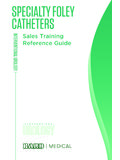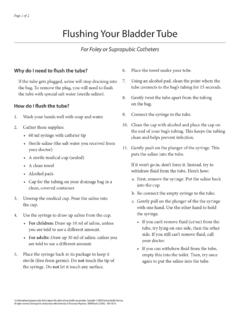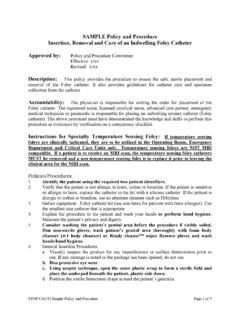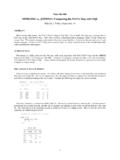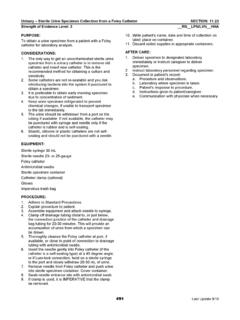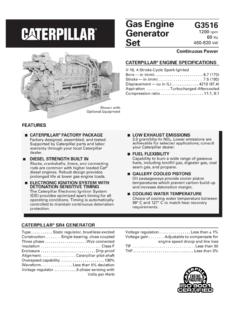Transcription of BARD ADVANCEFOLEY TRAY SYSTEM Insertion and …
1 Page 1 1208-66b BARD ADVANCE foley TRAY SYSTEM Insertion and removal skills training checklist Objectives: 1. Clinician will demonstrate understanding of the device indications, contraindications, warnings and precautions. 2. Clinician will demonstrate competency in the proper Insertion and removal of an indwelling urinary catheter. Supplies: BARD ADVANCE foley Catheter Tray Task Completed Trainer Initials foley Catheter Insertion 1. Confirm patient meets the CDC Guidelines for Appropriate Indications for Indwelling Urethral Catheter Use:1 Patient has acute urinary retention or bladder outlet obstruction Need for accurate urine output measurements Use for selected surgical procedures To assist in healing of open sacral or perineal wounds Patient requires prolonged immobilization To improve comfort for end of life care Select the smallest foley catheter possible, consistent with good drainage 2.
2 Preparation: Conduct a 15-30 second antiseptic hand wash and don clean gloves Open outer packaging, remove tray and open CSR wrap Position patient Place underpad beneath patient, plastic or shiny side down Use provided castile soap wipes to cleanse patient s peri-urethral area using downward strokes from anterior to posterior Discard gloves. Perform hand hygiene with provided alcohol hand sanitizer gel 3. Insert foley Catheter using aseptic technique and sterile equipment: Maintain aseptic technique and don sterile gloves Position fenestrated drape on patient appropriately Use the syringe with the green plunger to deposit lubricant into tray-top for foley catheter lubrication Remove top tray and place next to bottom tray (keep on CSR wrap) Attach the water-filled syringe to the inflation port Note: It is not necessary to pre-test the foley catheter balloon Remove foley catheter from wrap and lubricate catheter Prepare patient with packet of pre-saturated antiseptic swab sticks: Page 2 1208-66b a.
3 Female Patient: with a downward stroke cleanse the right labia minora and discard the swab. Repeat for left labia minora. Use the last swab stick cleanse the area between the labia minora b. Male Patient: Cleanse the penis in a circular motion starting at the urethral meatus and work outward Proceed with catheterization until urine is visible in the drainage tube: a. Female Patient: Advance catheter two more inches (or according to hospital protocol) b. Male Patient: Advance catheter 6-10 inches(or according to hospital protocol) Inflate catheter balloon using entire 10mL of sterile water provided in the prefilled syringe Note: Use of less than 10mL can result in improperly inflated balloon Once the balloon is inflated, ease the catheter back by gently pulling on the catheter until slight tension is detected indicating that the balloon is in place at the neck of the bladder If proper catheterization is not accomplished, use a new catheter for future attempts After inserting the foley catheter, discard all materials in accordance with the hospital protocol and remove contaminated gloves 4.
4 If provided, secure the foley catheter to the patient using the STATLOCK foley device Note: Please ensure patient is appropriate for use of STATLOCK foley device 5. Position hanger on bed rail at the foot of the bed and use green sheeting clip to secure drainage tube to sheet, confirm tube is not kinked 6. Indicate time and date of catheter Insertion on provided labels and place designated labels on patient chart and drainage SYSTEM 1. CDC HICPAC Guideline for Prevention of Catheter-Associated Urinary Tract Infections 2009. NAME AND TITLE UNIT DATE TRAINER NAME Page 3 1208-66b BARD ADVANCE foley TRAY SYSTEM Insertion and removal skills training checklist foley Catheter removal 1. Follow hospital protocol for the removal of a urinary catheter 2. Explain the procedure to the patient and ensure privacy 3. Conduct a 15-30 second antiseptic hand wash 4. Don clean gloves 5.
5 Remove STATLOCK foley device 6. Position patient and place waterproof pad under patient 7. Deflate catheter balloon: a. Back off syringe to and insert into the inflation port b. Allow the water to naturally flow back into the syringe to deflate the balloon c. Remove all 10mL of water d. Do not use vigorous aspiration as this may cause the inflation lumen to collapse, preventing balloon deflation e. Use only gentle aspiration to encourage deflation if needed f. Allow approximately 30 seconds for the pressure within the balloon to force the plunger back and volunteer its water into the syringe If slow or no deflation is noticed, reseat the syringe If balloon will not deflate and if permitted by hospital protocol, the valve arm may by severed. If this fails, contact adequately trained professional for assistance, as directed by hospital protocol If balloon rupture occurs, care should be taken to assure that all balloon fragments have been removed from the patient 8.
6 Remove the catheter and discard it according to hospital policy 9. Document procedure according to hospital protocol NAME AND TITLE UNIT DATE TRAINER NAME Please consult product inserts and labels for any indications, contraindications, hazards, warnings, cautions and directions for use. BARD and STATLOCK are registered trademarks of C. R. Bard, Inc. All other marks are the property of their respective owners. For more information on clinical training & education programs contact.

